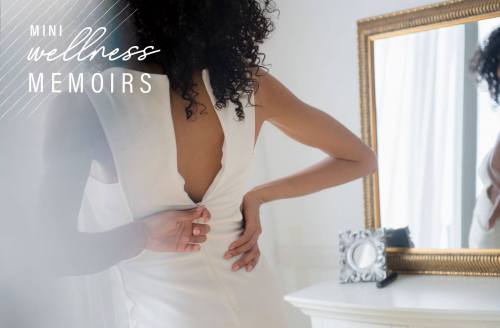How I reprogrammed my brain to stop seeing my cellulite as bad
In 2018, I decided to stop saying "yuck" when I looked in the mirror and saw cellulite. Because, yep, cellulite is normal. And it's a part of me.

Cellulite! I have it. My ass-and-back-of-thigh area, specifically, has it. I have a thin frame that has always fit into the standards of beauty pushed forth by the media, fashion industry, and general celebrity culture industrial complex, and yet the cellulite-y part of my body is an area that has always refused to fit the silky-smooth body ideals we’re used to seeing in razor ads and reality TV.
And, until I made a conscious change this year (thanks for the inspo, uplifting tweets and body-inclusive Instagram posts!), the voice in my head would automatically say “yuck” each time I’d look in the mirror and see cellulite.
From an early age, I’ve been taught to think cellulite is something shame-inducing, a personal failure, an unpreventable thing that somehow women are still supposed to feel bad about not preventing. When I was 12 or 13, I remember there was a news item on a morning talk show about Howard Stern asking Ben Affleck if his then-girlfriend Jennifer Lopez (Is it dating myself to remember Bennifer so vividly? Probably…) had cellulite on her very renowned backside. Affleck answered that question with a casual “no,” as if Stern’s question was a normal thing to be asked about one’s girlfriend, and as if cellulite was something that beautiful people weren’t supposed to have.
(Also can we talk for a second about how the word “cellulite” has the worst mouthfeel ever? It feels like a crappy cleaning product from the ‘50s, or an evil chemical crafted by a comic book villain.)
This summer, every time I turned around to see how my jorts were looking from the back (as one does) I saw my cellulite, and my initial response, as it has been ever since the cellulite first appeared, was to think, Ugh, this is gross. This looks bad. I wish it would go away.
The body inclusivity movement has pushed for visibility of real bodies: dimpled, squishy, hairy, unruly bods that all look incredible.
But the idea of what kinds of bodies and bodily features are allowed to be seen in pop culture has been changing. The body inclusivity movement has pushed for, among other things, visibility of real bodies: dimpled, squishy, hairy, unruly bods that all look incredible. Over the past year, my Instagram feed has gradually filled with women and non-binary folks celebrating the wonderful idiosyncrasies of their physical shapes, and the more I saw of this, the more I realized how narrow a view of beauty I had. Just think about what a newsworthy event it was when an Outdoor Voices Instagram advertisement showed a runner with visible cellulite. I saw that ad in my feed and thought, Hey! I, too, am a runner with cellulite. Also, those shorts are cute.
And so by August and September, I started to train my brain to drown out the insecurities, to immediately follow the “yuck,” with a “wait, no, nope, you look great and nothing about this is gross at all.”
My cellulite isn’t a personal failure—it’s a feature of my body that happens to accentuate my legs, which run a half marathon with my mom every year, and my ass, which has been shaken to Outkast’s “Hey Ya” at wedding dance floors across the country. It’s going to take a while to prevent that mental “yuck” from happening entirely, but for now, I’m happy to have that secondary voice chiming back to insist these dimples I have aren’t bad, or wrong, or shameful—they’re just part of me, and that means they’re worth liking.
While we’re on the topic of self-love, here’s why we need to stop conflating weight with self-worth. And here are 5 psychologist-approved ways to tame shame.
Sign Up for Our Daily Newsletter
Get all the latest in wellness, trends, food, fitness, beauty, and more delivered right to your inbox.
Got it, you've been added to our email list.








